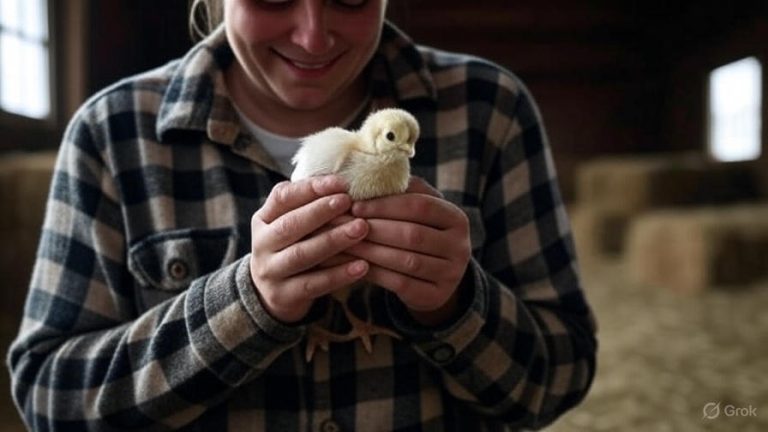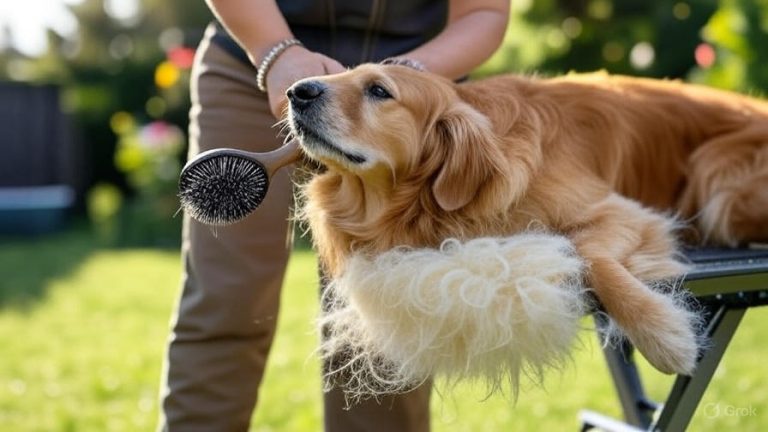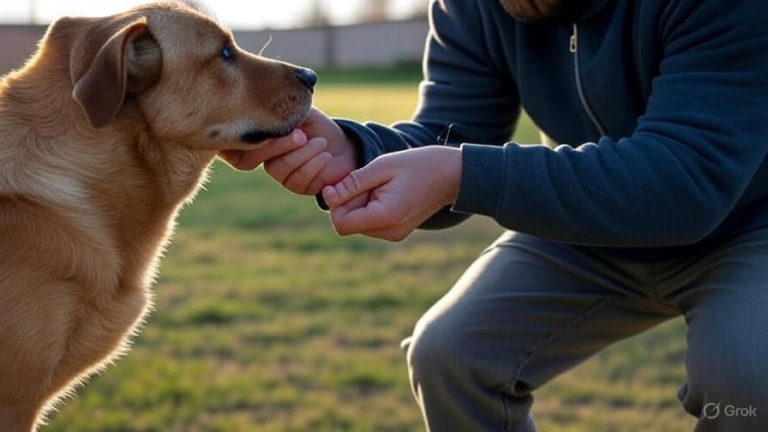How Bad Do Golden Retrievers Shed?
Golden retrievers rank among America’s most beloved dog breeds, and their gorgeous, flowing coats contribute significantly to their appeal. However, prospective owners often wonder about the reality of living with all that beautiful fur. The truth is straightforward: golden retrievers shed extensively, and potential owners need to prepare for year-round fur management.
The Reality of Golden Retriever Shedding
Golden retrievers shed heavily throughout the year, with two major shedding seasons that will test even the most dedicated dog owner’s patience. These dogs don’t just lose a few hairs here and there – they release substantial amounts of fur daily, creating what many owners affectionately call “golden tumbleweeds” throughout their homes.
The breed’s double coat system creates this shedding intensity. Their outer guard hairs protect against weather and debris, while the dense undercoat provides insulation. Both layers shed continuously, but the undercoat sheds most dramatically during seasonal transitions.
Dog hair becomes a constant presence in homes with golden retrievers. Owners find fur on furniture, clothing, carpets, and even in their food occasionally. This reality doesn’t diminish the breed’s wonderful qualities, but it does require honest expectations and consistent management strategies.
Understanding Golden Retriever Coat Structure
Golden retrievers possess a sophisticated double-layer coat system that explains their intense shedding patterns. The outer coat consists of longer, coarser guard hairs that repel water and protect the skin. These hairs grow continuously and shed regularly throughout the year.
The undercoat layer sits closer to the skin and consists of shorter, softer hairs that provide thermal regulation. This undercoat grows thicker during winter months and sheds heavily during spring and fall transitions. The undercoat shedding creates the most dramatic fur accumulation in homes.
Coat density varies among individual golden retrievers, with some dogs carrying thicker coats than others. Males typically develop fuller coats than females, though both sexes shed substantially. Age also affects coat density, as older dogs may develop thinner coats that shed differently than younger dogs.
The coat’s texture and color influence how visible shed hair appears in homes. Lighter-colored goldens may seem to shed less visibly on light surfaces, while darker furniture shows every golden hair. However, the actual shedding amount remains consistent regardless of how visible the fur appears.
Seasonal Shedding Patterns
Spring shedding begins as temperatures rise and daylight hours increase. Golden retrievers literally “blow” their winter undercoats during this period, releasing massive amounts of soft, fluffy fur. This process typically lasts four to six weeks and represents the heaviest shedding period of the year.
Fall shedding occurs as dogs prepare for winter by releasing their lighter summer coats. This seasonal transition involves less dramatic shedding than spring but still produces significantly more fur than typical daily shedding. The fall shedding period usually lasts three to four weeks.
Daily shedding continues throughout the year, even outside these major seasonal periods. Golden retrievers lose individual hairs constantly as part of their natural coat renewal process. This consistent shedding means owners never experience a “non-shedding” period with their golden retrievers.
Climate affects shedding patterns significantly. Dogs living in regions with distinct seasons experience more pronounced seasonal shedding, while those in consistently warm climates may shed more evenly throughout the year. Indoor heating and air conditioning can also influence natural shedding cycles.
Health Factors Affecting Shedding
Nutrition plays a crucial role in coat health and shedding intensity. Dogs receiving high-quality diets with appropriate protein levels and omega fatty acids typically maintain healthier coats with more manageable shedding. Poor nutrition can lead to excessive shedding, dull coats, and skin problems.
Stress significantly impacts shedding patterns in golden retrievers. Dogs experiencing anxiety, illness, or environmental changes often shed more heavily than normal. This stress-related shedding usually returns to normal levels once the stressful situation resolves.
Hormonal changes affect coat growth and shedding cycles. Female golden retrievers may experience increased shedding during heat cycles or after pregnancy. Spaying or neutering can also influence coat texture and shedding patterns, though these changes typically stabilize within a year of surgery.
Skin conditions, allergies, and parasites can cause abnormal shedding patterns. Excessive scratching from allergies or flea infestations can lead to patchy hair loss and increased shedding. Regular veterinary care helps identify and address these health-related shedding issues.
Age-related changes affect coat quality and shedding in senior golden retrievers. Older dogs may develop thinner coats that shed differently, or they may experience hormonal changes that influence their shedding patterns. Regular grooming becomes even more important for senior dogs.
Effective Grooming Strategies
Daily brushing represents the most effective method for managing golden retriever shedding. Regular brushing removes loose hairs before they fall naturally, reducing the amount of fur that ends up on furniture and floors. Consistency with brushing routines provides the best results.
Undercoat rakes work exceptionally well for removing loose undercoat hairs during heavy shedding periods. These specialized tools reach through the outer coat to capture the soft undercoat before it sheds naturally. Using undercoat rakes during seasonal shedding can dramatically reduce loose fur in homes.
Pin brushes help manage the outer coat and work well for daily maintenance brushing. These brushes smooth the outer coat while removing loose guard hairs. Many owners find pin brushes more comfortable for their dogs during regular grooming sessions.
Slicker brushes excel at removing mats and tangles that can worsen shedding problems. Matted fur tends to shed in larger clumps rather than individual hairs, making the mess more noticeable. Regular use of slicker brushes prevents mat formation and maintains healthy coat condition.
Professional grooming services provide deep cleaning and coat management that many owners cannot achieve at home. Professional groomers have specialized tools and techniques for managing heavy shedding periods. Most golden retriever owners benefit from professional grooming every 6-8 weeks.
Home Management Techniques
Vacuum cleaners designed for pet hair removal become essential tools for golden retriever owners. High-suction vacuums with specialized pet hair attachments can remove fur from carpets, upholstery, and hard floors effectively. Daily vacuuming may be necessary during heavy shedding periods.
Lint rollers and pet hair removal tools help maintain clothing and furniture between deep cleaning sessions. Many owners keep lint rollers in multiple locations throughout their homes for quick touch-ups. Rubber gloves can also effectively remove pet hair from fabric surfaces.
Washable furniture covers protect upholstery from fur accumulation while allowing easy cleaning. Many owners invest in covers that can be removed and washed regularly. This approach makes furniture maintenance much more manageable with heavy-shedding dogs.
Air purifiers help reduce airborne pet dander and loose hairs that float through indoor air. HEPA filters capture microscopic particles and can improve air quality for family members with mild pet allergies. Regular filter replacement maintains optimal air purification.
Strategic placement of washable rugs and mats in high-traffic areas catches loose fur before it spreads throughout the home. These rugs can be shaken out and washed regularly, making floor maintenance easier. Dark-colored rugs often hide golden hair better than light-colored options.
Diet and Supplement Solutions
High-quality protein sources support healthy coat growth and can reduce excessive shedding. Look for dog foods listing meat as the first ingredient and containing appropriate protein levels for your dog’s age and activity level. Quality nutrition forms the foundation of coat health.
Omega-3 fatty acids, particularly from fish oil sources, promote healthy skin and coat condition. These supplements can reduce inflammation and improve coat quality, potentially decreasing shedding intensity. Consult your veterinarian before adding supplements to your dog’s diet.
Adequate hydration supports healthy skin and coat function. Ensure your golden retriever has constant access to fresh water, as dehydration can worsen shedding problems. Some dogs benefit from adding moisture to their diet through wet food or bone broth.
Avoid foods that commonly trigger allergic reactions, as food allergies can increase shedding and cause skin problems. Common allergens include corn, wheat, soy, and certain proteins. If you suspect food allergies, work with your veterinarian to identify problematic ingredients.
Biotin and other B-vitamins support healthy coat growth and may help reduce shedding. Many high-quality dog foods contain adequate levels of these nutrients, but some dogs may benefit from additional supplementation. Always consult your veterinarian before adding supplements.
Debunking Common Myths
Many people believe that golden retrievers shed less in winter, but this myth ignores the breed’s natural coat cycles. While spring shedding is heaviest, golden retrievers shed year-round, and winter shedding preparation can be quite intense.
The myth that frequent bathing reduces shedding persists among some dog owners. However, excessive bathing can actually increase shedding by drying out the skin and coat. Most golden retrievers need baths only every 6-8 weeks unless they get particularly dirty.
Some owners believe that shaving their golden retriever will eliminate shedding problems. This practice can actually worsen shedding while damaging the coat’s natural growth patterns. Golden retrievers’ double coats should never be shaved completely.
The idea that indoor dogs shed less than outdoor dogs doesn’t hold true for golden retrievers. While outdoor exposure may affect coat condition, indoor dogs still experience natural shedding cycles. Climate-controlled indoor environments may actually prolong some shedding periods.
When to Consult a Veterinarian
Sudden increases in shedding intensity warrant veterinary attention, especially if accompanied by other symptoms. Dramatic changes in shedding patterns can indicate underlying health problems that require professional diagnosis and treatment.
Bald patches or areas of significant hair loss need immediate veterinary evaluation. These symptoms may indicate skin infections, allergies, hormonal imbalances, or other serious conditions. Early intervention often leads to better treatment outcomes.
Skin irritation, redness, or excessive scratching alongside increased shedding suggests possible allergic reactions or skin conditions. These symptoms require professional assessment to determine appropriate treatment approaches.
Changes in coat texture, color, or growth patterns may indicate nutritional deficiencies or health problems. Dull, brittle, or thinning coats often reflect underlying issues that veterinary care can address.
Living Successfully with a Heavy Shedder
Accept that golden retriever ownership includes constant fur management as part of daily life. Successful golden retriever owners adapt their cleaning routines and expectations to accommodate their dog’s shedding patterns. This acceptance reduces frustration and allows focus on the breed’s many positive qualities.
Establish realistic expectations about home cleanliness when living with golden retrievers. Homes with these dogs rarely maintain the pristine appearance possible with non-shedding pets. Regular cleaning and maintenance routines help manage fur accumulation effectively.
Invest in quality cleaning tools and grooming equipment from the beginning. Cheap tools often prove ineffective and require frequent replacement. Quality vacuums, brushes, and cleaning supplies make fur management much more efficient and effective.
Consider the impact of golden retriever shedding on family members with allergies before bringing one home. While no dog is truly hypoallergenic, golden retrievers rank among the worse choices for allergy sufferers due to their heavy shedding and dander production.
Conclusion
Golden retrievers shed heavily, and prospective owners must understand this reality before committing to the breed. These dogs produce substantial amounts of fur year-round, with intense seasonal shedding periods that require dedicated management strategies.
Success with golden retriever ownership depends on accepting their shedding nature and developing effective management routines. Daily brushing, regular grooming, quality nutrition, and appropriate cleaning tools make living with these heavy shedders much more manageable.
The joy and companionship that golden retrievers provide often outweigh the challenges of managing their shedding. Countless families happily share their homes with these wonderful dogs despite the constant presence of golden fur throughout their living spaces.
Proper preparation, realistic expectations, and consistent management techniques allow families to enjoy golden retriever ownership while maintaining reasonably clean homes. The key lies in understanding that shedding management becomes a permanent part of life with these beloved dogs.







